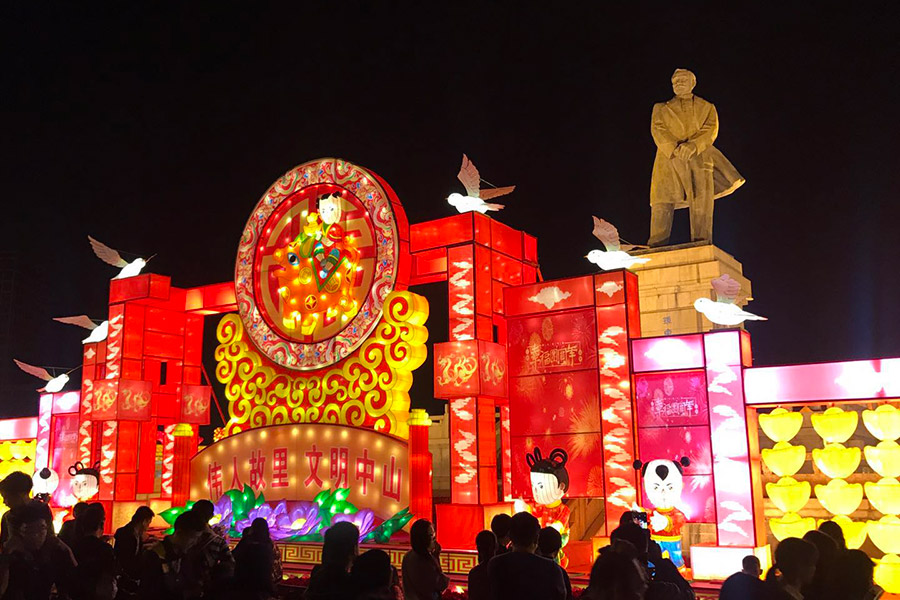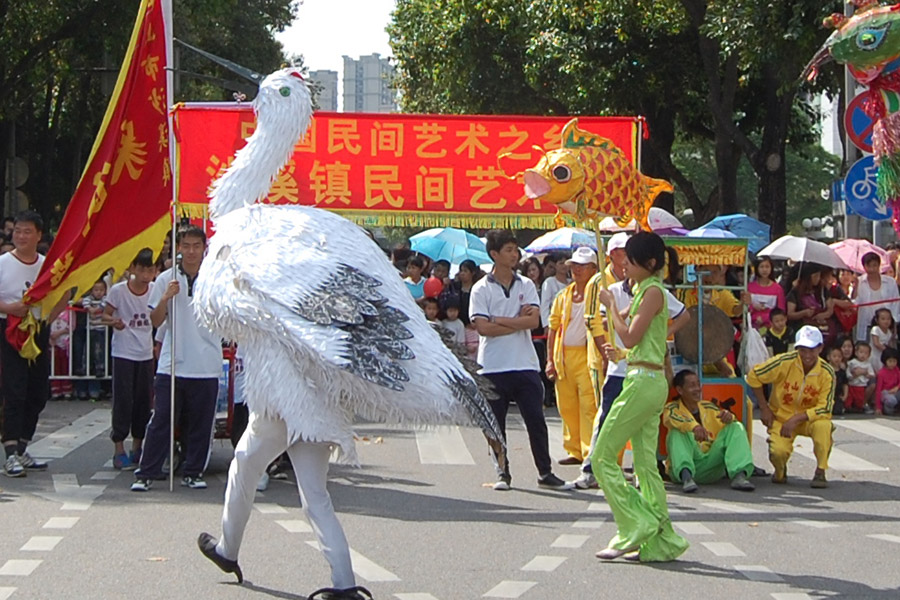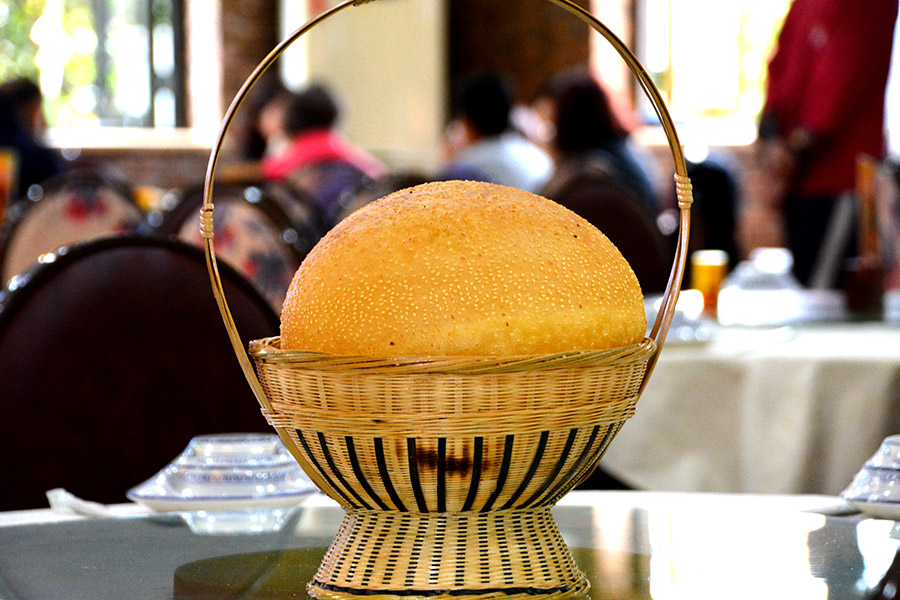 |
|
Lanterns at the Sun Yat-sen Memorial Park are a highlight of the Spring Festival holiday celebrations for the people of Zhongshan in Guangdong province. [Photo by Xu Fan/China Daily] |
Zhongshan's lanterns illuminate the local culture during Spring Festival, Xu Fan reports.
Zhongshan, South China's Guangdong province, is best known as the hometown of political and revolutionary leader Sun Yat-sen (1866-1925), known as the Father of Modern China.
The city is also worth a visit to witness how Lunar New Year is celebrated in Cantonese culture.
For many families in parts of the country it has become a sort of custom to watch China Central Television's Spring Festival Gala on the eve of Lunar New Year since the early 1980s. But for the residents of Zhongshan, it is more a time to stroll in the flower markets and appreciate festive lanterns, after eating nian ye fan, a meal for family reunions on Lunar New Year's Eve.
 |
|
A lion dance in Zhongshan during the holiday. [Photo provided to China Daily] |
The highest temperature in the subtropical city can reach 29C in February, when the traditional new year usually starts. The nights are warm, flowers start to bloom and a gentle breeze blows. While strolling in the city, locals first stop at the annual lantern fair and then go to the Shagangxu flower fair to purchase flowers to usher in the new year.
This year's lantern fair displayed 43 sets of lanterns across three venues: Sun Yat-sen Memorial Park, Yixian Lake Park and Zimaling Park, the province's largest park.
Unlike fairs in the northern cities of the country where the air is colder in winter, lanterns of different shapes and sizes are surrounded by chrysanthemums in Zhongshan.
The flowers are a highlight of Xiaolan, a nearby town.
The lantern fair, held over Feb 3-24 this year, had 60,000 chrysanthemum pots, with the major species being Dahlia pinnata, at all three exhibition venues, says Zhu Minghao, a fair organizer.
Chrysanthemums have become a part of the local lifestyle.
 |
|
A local acrobat performs a crane dance, which is unique to rural Zhongshan's holiday celebrations. |
Xiaolan's enthusiasm for chrysanthemums dates back some 700 years. People fleeing conflict around the time of the collapse of the Song Dynasty (960-1279) were attracted by fields of blooming chrysanthemums in Xiaolan back then, and decided to reside in the village, which later developed into a town.
During the Ming and Qing dynasties (1368-1911), locals held festivals to celebrate the flower in different ways, including artwork, poetry, feasts, competitions and performances.
In 2006, the Xiaolan Chrysanthemum Festival was inscribed on an early list of national-level intangible cultural heritage issued by the State Council, China's Cabinet.
While for most people, the chrysanthemum is an ornamental plant to be admired, the residents of Xiaolan also use it for cooking in chicken, fish, pork, beef and even snake dishes.
A blend of history and modern life is another highlight of the lantern fair, according to Zhu.
For instance, a set of five ceremonial column-shaped lanterns-with the relevant Chinese characters on them-symbolizes the city's goals, and covers an area of around 25 meters in diameter.
When hiking to a hill at the center of Sun Yat-sen Memorial Park, visi-tors can see giant lanterns shaped in the form of Cantonese Opera performers or featuring local delicacies. Cantonese cuisine is one thing that a tourist should not miss, and there could be more surprises if you taste food tailored for Lunar New Year.
Zha jian dui, a fried sweet dish made of glutinous rice ball coated with sesame seeds, is considered a "lucky food" and is prepared on the first day of Lunar New Year. It can be as big as a basketball or as small as a table tennis ball.
"To make this, you need to use a strainer to move the rice balls in circles in very hot oil. As the ingredients expand, the action is related to the Chinese character fa, which means fortune," explains Yang Guanhao, a local culture expert from Shaxi town in Zhongshan.
"For us, it's an auspicious food that will bring in gold and silver."
Other such snacks include jin qian quan, a deep-fried pastry resembling an ancient copper coin, which is believed to bring money, and nian gao, a glutinous rice-made dessert with its name having a similar pronunciation as "getting a promotion in a new year" in Chinese.
 |
|
Traditional delicacies such as zha jian dui, a sweet-tasting glutinous rice ball, is prepared as lucky food for Lunar New Year. [Photo by Yang Huanhao/For China Daily] |
Following these sweet appetizers, a lavish feast termed jiu da gui-made of nine top local dishes, including steamed pork with taro, braised duck with ge gen, a vine, and boiled sliced chicken-is served. Liyuan Longdu Restaurant is one of the best places in Shaxi to taste the traditional dishes, according to Yang.
In the past, villagers couldn't afford such delicacies on ordinary days and only expected to have a bite during grand festivals.
"Now most people probably find such traditional dishes a bit greasy, but they are still must-have festival dishes to remind us of the old days," Yang says.
Tourists who know about lion dance and dragon dance, two art forms that simulate the movements of the two creatures, will enjoy crane dance shows in rural Zhongshan. All such shows require acrobatic skills and years of training from the performers, says Zheng Yongji, a veteran performer in Zhongshan.
Unlike lion dance and dragon dance, which require two or more performers to manipulate the props, crane dance is performed by one artist who wears a crane costume.
The performance mimics typical crane movements, ranging from seeking fish in streams to flapping wings. These days, a performer also dresses up as a small fish that the cranes eat, says Lin Fengqun, a member of Zhongshan's intangible cultural heritage committee.
Dating back around 200 years and accompanied by singing in the local dialect, the crane dance symbolizes the diligent locals' yearning for a better future, says Lin.
So, for those who are interested in less well-known Chinese tradition and culture, Zhongshan might be a good place to visit during the next Lunar New Year holiday.
Contact the writer at xufan@chinadaily.com.cn

Presented by Chinadaily.com.cn Registration Number: 10023870-7
Copyright © Ministry of Culture, P.R.China. All rights reserved